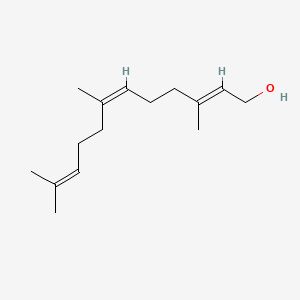| MeSH term | MeSH ID | Detail |
|---|---|---|
| Adenocarcinoma | D000230 | 166 associated lipids |
| Lupus Erythematosus, Systemic | D008180 | 43 associated lipids |
| Lung Neoplasms | D008175 | 171 associated lipids |
| Pancreatic Neoplasms | D010190 | 77 associated lipids |
| Colonic Neoplasms | D003110 | 161 associated lipids |
| Body Weight | D001835 | 333 associated lipids |
| Edema | D004487 | 152 associated lipids |
| Prostatic Neoplasms | D011471 | 126 associated lipids |
| Osteosarcoma | D012516 | 50 associated lipids |
| Glioma | D005910 | 112 associated lipids |
(e,z)-farnesol
(e,z)-farnesol is a lipid of Prenol Lipids (PR) class.
Cross Reference
There are no associated biomedical information in the current reference collection.
Current reference collection contains 3613 references associated with (e,z)-farnesol in LipidPedia. Due to lack of full text of references or no associated biomedical terms are recognized in our current text-mining method, we cannot extract any biomedical terms related to diseases, pathways, locations, functions, genes, lipids, and animal models from the associated reference collection.
Users can download the reference list at the bottom of this page and read the reference manually to find out biomedical information.
Here are additional resources we collected from PubChem and MeSH for (e,z)-farnesol
Possible diseases from mapped MeSH terms on references
We collected disease MeSH terms mapped to the references associated with (e,z)-farnesol
PubChem Biomolecular Interactions and Pathways
All references with (e,z)-farnesol
Download all related citations| Authors | Title | Published | Journal | PubMed Link |
|---|---|---|---|---|
| Cordeiro RA et al. | Minimum inhibitory concentrations of amphotericin B, azoles and caspofungin against Candida species are reduced by farnesol. | 2013 | Med. Mycol. | pmid:22712455 |
| Zhang X et al. | PEG-farnesylthiosalicylate conjugate as a nanomicellar carrier for delivery of paclitaxel. | 2013 | Bioconjug. Chem. | pmid:23425093 |
| Brilhante RS et al. | Effect of farnesol on growth, ergosterol biosynthesis, and cell permeability in Coccidioides posadasii. | 2013 | Antimicrob. Agents Chemother. | pmid:23459491 |
| Charette N et al. | Salirasib sensitizes hepatocarcinoma cells to TRAIL-induced apoptosis through DR5 and survivin-dependent mechanisms. | 2013 | Cell Death Dis | pmid:23348585 |
| Schmukler E et al. | Ras inhibition enhances autophagy, which partially protects cells from death. | 2013 | Oncotarget | pmid:23370967 |
| Kraitzer A et al. | Mechanisms of antiproliferative drug release from bioresorbable porous structures. | 2013 | J Biomed Mater Res A | pmid:23065767 |
| Barkan B et al. | Ras inhibition boosts galectin-7 at the expense of galectin-1 to sensitize cells to apoptosis. | 2013 | Oncotarget | pmid:23530091 |
| Lazzerini PE et al. | Rosuvastatin inhibits spontaneous and IL-1β-induced interleukin-6 production from human cultured osteoblastic cells. | 2013 | Joint Bone Spine | pmid:22999910 |
| Mor A et al. | Celecoxib enhances the anti-inflammatory effects of farnesylthiosalicylic acid on T cells independent of prostaglandin E(2) production. | 2012 | Inflammation | pmid:22688643 |
| Mologni L et al. | Synergistic effects of combined Wnt/KRAS inhibition in colorectal cancer cells. | 2012 | PLoS ONE | pmid:23227266 |
